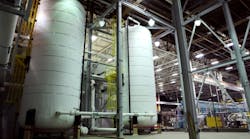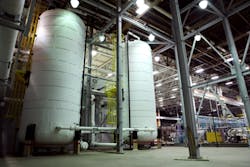LOUISVILLE, KY. — GE Appliances & Lighting has a new data center — the first United States Green Building Council LEED-Platinum certified data center in all of Kentucky — at its Appliance Park headquarters here. Rather than building the new data center from scratch, GE revitalized an existing building for the new data center.
According to GE, the data center is 34% better in terms of energy savings than a typical code-compliant building when compared to the ASHRAE 90.1 building code for energy efficiency.
GE maintained 98.3% of the walls, floors and roof of unutilized factory space, and the data center’s mechanical systems are quite impressive: two 27,000-gal. thermal storage tanks and two 500-ton redundant chillers cool the facility. The two redundant chillers by Trane are located on the roof, supplying 56°F water to the mechanical systems.
“Water from the chillers is piped directly to the thermal storage tanks, then it is sent out to the different air handling systems throughout the data center,” explained Chad Allen, project manager, Holder Construction, Atlanta. “When return air from the air handling units in the floor crosses the chilled water coils within an air handling unit, the heat from the room is then transferred into the chilled water, which inherently warms it up a bit. The warmer water is then recirculated back to the chillers and the cycle starts over again.”
The chillers are redundant, so one chiller can handle the load of the entire facility if the other chiller needs to be maintained.
“If both chillers are not operational at the same time then the thermal storage tanks act asa reservoir for the chilled water sent out to the units serving the data floor,” said Allen. “Water that is recirculated then goes directly back to the storage tanks, bypassing the chillers, so the GE team can work on the chillers to bring them back online.”
The data center’s generators are 2,250 kW, and are only used in the event of a power outage.
“The generators backup everything, if there is a power failure,” said Gregory Jasmin, co-managing director of Syska Hennessy Group MENA, headquartered in New York. “The thermal storage tanks back up the chillers, the UPS (uninterruptable power supply) carries everything through as everything is restarting up. Even with the worst case scenario, such as the power goes out and chillers stop working, the data center is still functioning at its peak without the equipment ever going down.”
Design, installation
In addition to installing an innovative high-efficiency cooling system, GE installed high-density servers. Each rack of servers is designed to run at 18 kW to 24 kW per cabinet, to pack more computing power per square foot, reducing the size of the data center floor by half compared to the data center it replaced. This means that less energy is needed to cool the space. GE is also matching 35% of the data center’s predicted annual energy consumption with renewable-energy certificates to help offset emissions.
Typical for most data centers, a raised floor was installed, but the height of it — four feet — is taller than most raised floors found in data centers. The 4-ft. floor generates enough air to cool the high density racks.
“If you look at the data center design, it’s a relatively small room for the load that it has,” said Jasmin. “If you walk down the center of the room there are racks to the left and right. This was done to maximize the cooling capacity of the raised floor. The configuration was geared towards a high density solution, and the layout maximized the efficiency we are getting out of our cooling equipment.”
“Our chief HVAC engineer worked closely with GE to layout an optimal solution to have the right mechanical systems to do an all-air cooled high density solution,” added Jasmin. “The preliminary aspects took four to six weeks to work the concepts, which set the baseline. Then we did the standard schematic design, which took about six to seven months.
Schardein Mechanical, based in Louisville, Ky., installed the mechanical equipment, which included setting the equipment, installing piping, and filling the chilled water system, all in about five months. Approximately 20 men worked on the job, maxing out at about 30.
According to Allen, hoisting the mechanical equipment to the roof was a challenge that was overcome.
“Based on the location of the roof top units on the existing facility, we weren’t able to use a crane in many instances, so we ended up using a helicopter to set some of the large equipment on the roof,” said Allen. “Another project-specific challenge was tying into the existing infrastructure to feed the building.”
Regarding the design, challenges faced were working with the infrastructure on the existing campus.
“First we had to understand the existing systems, so we could find out the best way to tie into the existing infrastructure to feed the building,” said Jasmin. “Some of it was very helpful, such as the onsite retention pond for the fire protection systems, but trying to tie into an existing utility building that was many years old was challenging, but it came down to having the right people that knew the infrastructure and our team and its experience designing the best solution with the constraints we had.”
Besides saving energy, GE is also reducing water consumption inside the building by installing ultra low-flow fixtures.
For the toilets, GE is using low-flow flush valves and the urinals are also low-flow fixtures as well.
“The water closets and urinals are both manufactured by Sloan,” said Allen. “GE also now has low-flow Kohler faucets in the restrooms and Kohler faucets in the kitchen. Also, the landscaping for the project didn’t require an irrigation system.”
The new data center supports GE Appliances’ $1 billion investment to upgrade all of its major appliance product lines and create Manufacturing Centers of Excellence. The new data center operates information systems that enable technology and manufacturing teams to run state-of-the-art factories and implement lean manufacturing processes that improve operational efficiencies to drive down cost; improve customer service through increased fill rates and better billing systems; and enhance product quality and innovation.



